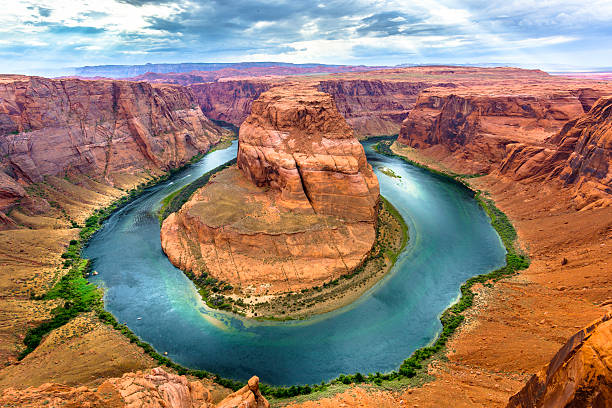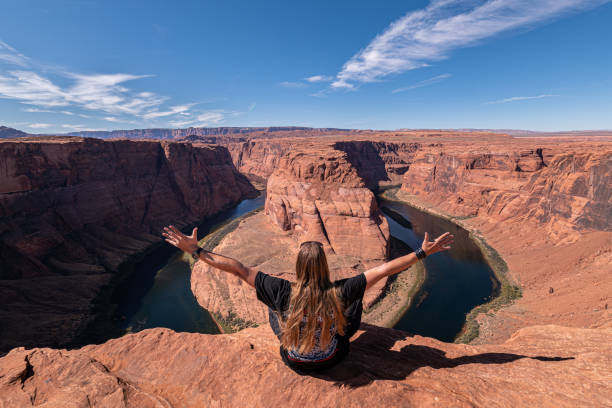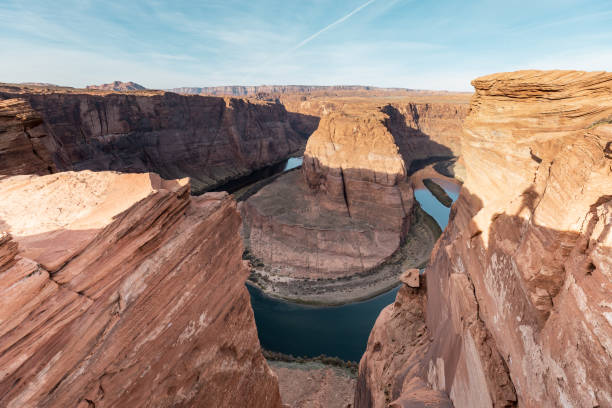
Horseshoe Lake In Arizona: The Complete Travel Guide
The ideal place to visit while taking a Southwest American tour is Horseshoe Bend, Arizona. It’s a picturesque Colorado River bend that has quickly gained recognition as a top spot for taking pictures of the breathtaking southwest landscape.
Horseshoe Bend has undoubtedly been captured on camera many times, but images simply cannot do this natural marvel justice. On our 10-day trip along the West Coast of the United States, we made a stop at Horseshoe Bend, where we were astounded by the beauty of the horseshoe-shaped canyon.
Table of Contents
The Basics
When to Go
Horseshoe Bend is accessible every day from dawn until dusk, but most visitors arrive between 9 and 11 a.m. and 4:30 to 6:30 p.m. to catch the sunset. By going at sunrise or during the workweek, you can avoid crowds.
Although there are fewer people around in the early afternoon, temperatures are at their highest, and the sun’s glare prevents the canyon walls from displaying their vibrant colors as they do in the morning and later in the day.
What You Will Need
Water is essential, especially in the summer. Every two hours, bring one liter per person. For a hike in the desert, bring some small snacks and appropriate clothing. You should wear:
• Closed-toed footwear (sandals are not permitted!)
• Sunglasses
• Wide-brimmed hat
• Sunscreen—there’s very little shade on the trail or at the rim
What It Costs
Although there is no entrance fee for Horseshoe Bend, Page owns the land where the parking lot is situated. For parking in the lot, the city levies a fee of $10 per car or RV and $5 per motorcycle. You are not eligible for a discount with national park passes.
What to Bring
It goes without saying that you should have a camera, ideally one with a wide-angle lens. (Most smartphones have a wide-angle or panorama mode that can be used to capture the scene.) Binoculars might be useful if you don’t have a telephoto lens to observe rafters negotiating the river’s bend below. We forbid the use of drones.
Dress in layers if you visit in the winter. While hiking, you’ll probably get sweaty, but if the wind is blowing, standing on the rim, you should be prepared to get cold.
How to Get to Horseshoe Bend
Driving is undoubtedly the most straightforward way to reach Horseshoe Bend.
Depending on exactly when you’re traveling, the best car rental company for your trip to Arizona will probably change significantly. Local businesses occasionally have the best deals, as well as occasionally big international carriers. Sometimes a company will have great base pricing but awful rental requirements.
The best way to find a rental car for your road trip is to use Discover Cars, which will sort through dozens of businesses to find the best deal on low rates and fair rental conditions.
We’ve taken a number of road trips in the southwest over the years, and we’ve never used or needed a 4-wheel drive. However, if you want to venture far from the (literally) beaten path, you might want to think about renting one!

What to Do Once You Get There
Hiking
There are a few options near Horseshoe for hikes in the Tonto National Forest. Nevertheless, they aren’t as obvious as you might anticipate.
We had a difficult time locating any good hiking trails when we first came up here. We, therefore, made our way to the dam. Once there, we were thrilled to discover a walkway that passes beneath the moving water. These waterfalls are quite stunning. And you can see the magnificent “back-side of water.” Having said that, since this is a dam, caution must be exercised when exploring the area. For starters, never enter an area where warning signs direct you to stay away. If the lake is being cleared or the water appears to be high, don’t try to cross. It also goes without saying, but don’t try to enter the water below the dam. There’s a chance you’ll get swept over the falls.
The dirt Horseshoe Lake Road can be followed for as short or as long of a hike as you like if you cross the dam. On the other side of the river, it is quite lovely and serene.
Fishing
Crappie, Large and Smallmouth Bass, Channel and Flathead Catfish, Carp, and Bluegill are just a few of the fish you can find in Horseshoe Lake, Arizona. Although there is a nice variety here, Horseshoe is frequently drained until it is almost completely dry whenever the water in the reservoir is required. It is the first artificial lake to fill up when water is needed because it is part of the Salt River Project system that supplies Phoenix and the surrounding areas.
Don’t take fish that have been left out in the mud if you plan to go fishing and arrive at this time. When that is the case, they are not suitable for consumption. Naturally, you must make sure that you have the appropriate fishing licenses because Horseshoe is located on Tonto National Forest property.
Boating
A ramp is accessible if you can carry a small boat out to the lake. The road leading to Horseshoe can be quite difficult, though. Therefore, unless you are bringing small craft or kayaks, this may not be the best location for a day on the water. Furthermore, you might be let down if you bring your boat all the way up there only to discover that there isn’t enough water to enjoy because the lake is frequently drained. (Bartlett Lake, which is immediately downstream, would be a simpler option.
Additionally, there are rumors of debris just below the water’s surface, which could make paddling challenges. Therefore, even though boating is an option here, we wouldn’t be the first to recommend it.
Camping
Around Horseshoe Lake, Arizona, there are many different camping options. You may experience some peace and quiet here because of the lake’s relative remoteness. (In spite of that, this location was quite busy during the COVID-19 pandemic. There are several different unimproved camping locations close to the lake that are just a short distance from some outhouses. There are additional options accessible beneath the Verde River dam. In the event that the dam was to break, you would be in a dangerous position if you were below it, so you should be aware of this. Expect to be in impoverished circumstances in either scenario.
For the same reason, we would be hesitant to advise bringing a boat up here, we would also be hesitant to advise doing so with a camping trailer. It is a rough, narrow road. It’s actually one of the few roads where we were compelled to use 4-wheel. Bring a tent if you plan to camp!
An upper limit of 14 days is imposed, and camping costs $16 per night. Campground fees cannot be paid on-site; they must be paid at the Cave Creek District Office.

Where to Stay Near Horseshoe Bend
The town of Page, close to Horseshoe Bend, Arizona, is without a doubt the best place to stay while traveling there.
Even though Page is a small town, there are many hotels and lodging options there.
Here are a few highly rated accommodations to take into account for your trip.
Budget
Super 8 By Wyndham is the ideal choice for a low-budget traveler seeking a cozy lodging choice in the middle of town. It is clean, well-liked, and offers a pool in the summer. Super 8 By Wyndham is situated a 6-minute drive from Horseshoe Bend.
Mid-range
One of the most well-liked places to stay in Page is the Best Western View of Lake Powell Hotel, which boasts fantastic reviews and even better sunset views.
Summary: Safe Travels!
We sincerely hope you found this article helpful and that it contributed to the unforgettable experience of your trip to Horseshoe Bend. Please feel free to ask any questions in the comments section below. We’ll be glad to assist. Safe travels!


